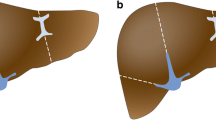Abstract
Background
The purpose of this study was to describe our experience, particularly for CT features, with four patients who had pathologically proven sclerosing hepatic carcinoma that mimicked other malignant hepatic tumors with abundant fibrosis at CT.
Methods
Over a 10-year period, we collected four patients with surgically proven sclerosing hepatic carcinoma. All patients were men (age range, 49–63 years; mean, 56 years). Three-phase helical CT images were obtained in all patients, and their CT features were correlated with pathologic findings.
Results
The tumor size ranged from 2.7 to 11 cm (mean, 7.2 cm). The tumors were manifested as a hypoattenuating mass with peripheral, rim enhancement at hepatic arterial phase, followed by centripetal enhancement progressively during portal venous and equilibrium phases. Histopathologically, the tumors showed features intermediate between hepatocellular carcinoma and cholangiocarcinoma with abundant fibrosis and surrounding liver had no liver cirrhosis.
Conclusion
As described above, the CT features of sclerosing hepatic carcinoma may be similar to other malignant hepatic tumors with abundant fibrosis. Although sclerosing hepatic carcinoma is extremely rare, the radiologists should recognize that this tumor may be one of the malignant hepatic tumors with abundant fibrosis, especially in the non-cirrhotic liver.



Similar content being viewed by others
References
Omata M, Peters RL, Tatter D (1981) Sclerosing hepatic carcinoma: relationship to hypercalcimia. Liver 1:33–49
Park C, Park YN (1994) Immunohistochemical profile of sclerosing hepatic carcinoma. Korean J Pathol 28:636–642
Llovet JM, Miquel R (1999) Sclerosing hepatic carcinoma in non-cirrhotic liver resembling metastatic adenocarcinoma. J Hepatol 30:161
MacSween RNM, Burt AD, Portmann BC, et al. (2002) Pathology of the liver, 4th ed. London: Churchill Livingstone, pp 711–775
Kim H, Park C, Han KH, et al. (2004) Primary liver carcinoma of intermediate (hepatocyte-cholangiocyte) phenotype. J Hepatol 40:298–304
Maeda A, Ebata T, Matsunaga K, et al. (2005) Primary liver cancer with bidirectional differentiation into hepatocytes and biliary epithelium. J Hepatobiliary Pancreat Surg 12:484–487
Wu P, Lai V, Fang J, et al. (1996) Classification of hepatocellular carcinoma according to hepatocellular and biliary differentiation markers: clinical and biological implications. Am J Pathol 149:1167–1175
Robrechts C, De Vos R, Van den Heuvel M, et al. (1998) Primary liver tumor of intermediate (hepatocyte-bile duct cell) phenotype: a progenitor cell tumour? Liver 18:288–293
Matsuura S, Aishima S, Taguchi K, et al. (2005) ‘Scirrhous’ type hepatocellular carcinomas: a special reference to expression of cytokeratin 7 and hepatocyte paraffin 1. Histopathology 47:382–390
Yoshikawa J, Matsui O, Kadoya M, et al. (1992) Delayed enhancement of fibrotic areas in hepatic masses: CT-pathologic correlation. J Comput Assist Tomogr 16:206–211
Yamashita Y, Fan ZM, Yamamoto H, et al. (1993) Sclerosing hepatocellular carcinoma: radiologic findings. Abdom Imaging 18:347–351
Hong T, Lee R, Chiang J, Chang C (2001) Centrally-located sclerosing hepatocellular carcinoma: a case report with imaging findings before and after transcatheter arterial chemoembolization. Chin J Radiol 26:147–152
Blachar A, Federle MP, Brancatelli G (2002) Hepatic capsular retraction: spectrum of benign and malignant etiologies. Abdom Imaging 27:690–699
Author information
Authors and Affiliations
Corresponding author
Rights and permissions
About this article
Cite this article
Kim, S.H., Lee, W.J., Lim, H.K. et al. Sclerosing Hepatic Carcinoma: Helical CT Features. Abdom Imaging 32, 725–729 (2007). https://doi.org/10.1007/s00261-006-9174-0
Published:
Issue Date:
DOI: https://doi.org/10.1007/s00261-006-9174-0




